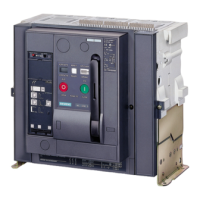WL Circuit Breaker
1/2
WL Selection and Application Guide • 2005
3 pole, up to 5000A
The ever-increasing use of
plant and energy management
systems has intensified the
demand for circuit breakers
supporting multiple open
protocols to monitor and
control the flow of energy
in the power system.
The extensive and modular
WL family of circuit breakers
and accessories provides this
for applications from 200A
to 5000A.
Applications
WL breakers can be applied
as main, tie, feeder or
distribution breakers in
low-voltage electrical power
systems.
Versions
• Frame ratings: 800A to
5000A
• 3 physical frame sizes
• Rated nominal operating
voltage up to 600V AC
• Seven interrupting classes
from 50kA to 200kA
at 480V
• Circuit breaker or non-
automatic switch
• WL Circuit Breakers are
delivered as complete
assembled breakers or
individual frames, guide
frames and accessories
Installation Types
Fixed-mounted or Draw-out
version
Standards
- WL ANSI / UL 1066 Circuit
Breakers will satisfy:
C37.13, C37.16, C37.17,
C37.50, NEMA SG3
- WL UL 489 Circuit Breakers
will satisfy: UL 489
CSA C22.2 No. 5-02
NMX-J-266-ANCE-2002
- WL Circuit Breakers are
suitable for use in UL 1558 LV
Switchgear and UL 891 LV
Switchboards.
Conditions of Application
WL Circuit Breakers are
designed to meet standard
Industrial and Commercial
application requirements.
Uniform Dimensions
WL Circuit Breaker dimensions
differ only in the device width,
which varies by frame size.
With the exception of the
200kA ANSI Frame Size II
which has an additional 5” in
depth to accommodate
integral fuses and the UL 489
Frame Size I which measures
only 15” in height to allow six-
high stacking in switchboards.
Minimal Space Requirements
The WL design is extremely
compact without sacrificing
performance and does not use
energy-wasting heat sinks.
Trip Units
The electronic,
microprocessor-based trip unit
is auxiliary voltage-
independant for all protective
functions and enables
adaptation to the different
protection requirements of
distribution systems, motors,
transformers and generators.
Non-Automatic Switch
A special version of the circuit
breaker is used as a non-
automatic switch. The non-
automatic switch is
constructed without a trip
unit and has no protective
function. A possible
application is for use as a tie-
in system with parallel feeds.
Main Bus Connectors
Breakers are equipped with
standard vertical main bus
connections. Horizontal bus
connections are available as
an option in Frame Size 1 and
2 up to 2000A.
Communication Capability
MODBUS or PROFIBUS
communications transmit the
acquired and metered data,
such as current values, breaker
status, trip log, etc. to a
central monitoring computer.
When the optional metering
function is installed, the
WL acquires data useful for
power management and can
contribute to a significant
savings in energy costs.
A new, internal circuit breaker
bus enables the expansion
of breaker functionality
through the integration of
many secondary functions
which were previously
separate, including:
• Control of analog displays
• Options for testing the
communication setup
• Display of breaker status
and reason for trip
• Input modules for reading
other external signals
and transmitting these
signals via PROFIBUS or
MODBUS communication
• A selection of output
modules to provide contact
closures based on events or
measured-value setpoints.
It is not only possible to
monitor the breaker
remotely, it is also possible
to open and close
the breaker as well as
setting parameters remotely.
Operating Mechanisms
Circuit breakers can be
optionally delivered with
different operating
mechanisms, including:
• Manual operating
mechanism with mechanical
closing (standard)
• Manual operating
mechanism with mechanical
and electrically interlocked
closing
• Motorized operating
mechanism with mechanical
and electrically interlocked
closing. Operating
mechanisms with electrically
interlocked closing are
suitable for synchronizing
tasks.
Auxiliary Contacts
Auxiliary switches can be
added according to the type
of installation. They are easily
mounted via front, top
mounted terminal blocks.
Modularity
Common guide frames for
the draw-out version make
them completely
interchangeable between
the UL 489 and ANSI / UL
1066 rated circuit breakers.
Components, such as auxiliary
releases, motorized operating
mechanisms, trip units,
current sensors, auxiliary
signal switches, automatic
reset devices or interlocks can
be used to modify or retrofit
any circuit breaker to meet
changing requirements.
The main contacts can be
replaced to extend the life of
the circuit breaker and feature
integrated contact wear
indicators.
Electronic Trip Unit
Modularity
Modularity is the outstanding
feature of the new WL Circuit
Breakers. The trip units
themselves can be retrofitted
with special LCDs, ground fault
modules, rating plugs and
communication modules.
100% Rated Circuit Breaker
WL circuit breakers are
designed for continuous
operation at 100% of their
current rating without the
need for external heat sinks.
Conditions of Application
WL Circuit Breakers are
designed to meet standard
Industrial and Commercial
application requirements.
Breaker Description
WL_SA_intro-sec1.qxd 2/7/05 1:20 PM Page 4

